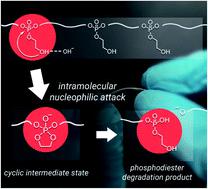当前位置:
X-MOL 学术
›
Chem. Sci.
›
论文详情
Our official English website, www.x-mol.net, welcomes your feedback! (Note: you will need to create a separate account there.)
RNA-inspired intramolecular transesterification accelerates the hydrolysis of polyethylene-like polyphosphoesters
Chemical Science ( IF 8.4 ) Pub Date : 2021-11-23 , DOI: 10.1039/d1sc05509g Tobias P Haider 1 , Oksana Suraeva 1 , Ingo Lieberwirth 1 , Piotr Paneth 2 , Frederik R Wurm 3
Chemical Science ( IF 8.4 ) Pub Date : 2021-11-23 , DOI: 10.1039/d1sc05509g Tobias P Haider 1 , Oksana Suraeva 1 , Ingo Lieberwirth 1 , Piotr Paneth 2 , Frederik R Wurm 3
Affiliation

|
To synthesize new (bio)degradable alternatives to commodity polymers, adapting natural motives can be a promising approach. We present the synthesis and characterization of degradable polyethylene (PE)-like polyphosphoesters, which exhibit increased degradation rates due to an intra-molecular transesterification similar to RNA. An α,ω-diene monomer was synthesized in three steps starting from readily available compounds. By acyclic diene metathesis (ADMET) polymerization, PE-like polymers with molecular weights up to 38 400 g mol−1 were obtained. Post-polymerization functionalization gave fully saturated and semicrystalline polymers with a precise spacing of 20 CH2 groups between each phosphate group carrying an ethoxy hydroxyl side chain. This side chain was capable of intramolecular transesterification with the main-chain similar to RNA-hydrolysis, mimicking the 2′-OH group of ribose. Thermal properties were characterized by differential scanning calorimetry (DSC (Tm ca. 85 °C)) and the crystal structure was investigated by wide-angle X-ray scattering (WAXS). Polymer films immersed in aqueous solutions at different pH values proved an accelerated degradation compared to structurally similar polyphosphoesters without pendant ethoxy hydroxyl groups. Polymer degradation proceeded also in artificial seawater (pH = 8), while the polymer was stable at physiological pH of 7.4. The degradation mechanism followed the intra-molecular “RNA-inspired” transesterification which was detected by NMR spectroscopy as well as by monitoring the hydrolysis of a polymer blend of a polyphosphoester without pendant OH-group and the RNA-inspired polymer, proving selective hydrolysis of the latter. This mechanism has been further supported by the DFT calculations. The “RNA-inspired” degradation of polymers could play an important part in accelerating the hydrolysis of polymers and plastics in natural environments, e.g. seawater.
中文翻译:

RNA启发的分子内酯交换加速了聚乙烯样多磷酸酯的水解
为了合成商品聚合物的新(生物)可降解替代品,适应自然动机可能是一种很有前途的方法。我们介绍了可降解聚乙烯 (PE) 样多磷酸酯的合成和表征,由于类似于 RNA 的分子内酯交换,其表现出更高的降解率。从容易获得的化合物开始,分三步合成 α,ω-二烯单体。通过无环二烯复分解(ADMET)聚合,获得了分子量高达38 400 g mol -1的类PE聚合物。聚合后官能化得到完全饱和和半结晶聚合物,精确间距为 20 CH 2每个磷酸基团之间带有乙氧基羟基侧链的基团。该侧链能够与主链进行分子内酯交换,类似于 RNA 水解,模拟核糖的 2'-OH 基团。热性能通过差示扫描量热法 (DSC ( T m ca.85 °C)) 并通过广角 X 射线散射 (WAXS) 研究晶体结构。与没有侧链乙氧基羟基的结构相似的聚磷酸酯相比,浸入不同 pH 值的水溶液中的聚合物膜被证明加速降解。聚合物降解也在人造海水(pH = 8)中进行,而聚合物在生理 pH 值为 7.4 时是稳定的。降解机制遵循分子内“受 RNA 启发的”酯交换反应,其通过核磁共振光谱检测以及通过监测不含侧羟基的聚磷酸酯和受 RNA 启发的聚合物的聚合物混合物的水解,证明了选择性水解后者。DFT 计算进一步支持了这种机制。例如海水。
更新日期:2021-12-01
中文翻译:

RNA启发的分子内酯交换加速了聚乙烯样多磷酸酯的水解
为了合成商品聚合物的新(生物)可降解替代品,适应自然动机可能是一种很有前途的方法。我们介绍了可降解聚乙烯 (PE) 样多磷酸酯的合成和表征,由于类似于 RNA 的分子内酯交换,其表现出更高的降解率。从容易获得的化合物开始,分三步合成 α,ω-二烯单体。通过无环二烯复分解(ADMET)聚合,获得了分子量高达38 400 g mol -1的类PE聚合物。聚合后官能化得到完全饱和和半结晶聚合物,精确间距为 20 CH 2每个磷酸基团之间带有乙氧基羟基侧链的基团。该侧链能够与主链进行分子内酯交换,类似于 RNA 水解,模拟核糖的 2'-OH 基团。热性能通过差示扫描量热法 (DSC ( T m ca.85 °C)) 并通过广角 X 射线散射 (WAXS) 研究晶体结构。与没有侧链乙氧基羟基的结构相似的聚磷酸酯相比,浸入不同 pH 值的水溶液中的聚合物膜被证明加速降解。聚合物降解也在人造海水(pH = 8)中进行,而聚合物在生理 pH 值为 7.4 时是稳定的。降解机制遵循分子内“受 RNA 启发的”酯交换反应,其通过核磁共振光谱检测以及通过监测不含侧羟基的聚磷酸酯和受 RNA 启发的聚合物的聚合物混合物的水解,证明了选择性水解后者。DFT 计算进一步支持了这种机制。例如海水。



























 京公网安备 11010802027423号
京公网安备 11010802027423号